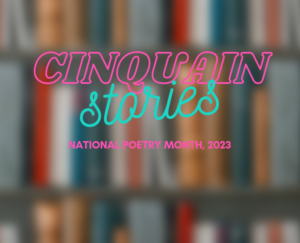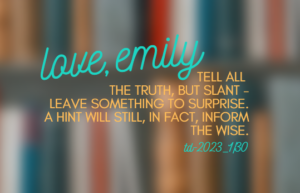It’s April! Happy National Poetry Month!
How do Cinquain become STORIES? I’m primarily a prose writer; inventing, and then recounting (slightly pointless, possibly plotless) stories has been something I’ve done since I was a wee tiny thing. While I love stories, as a young reader, I primarily disliked novels in verse – too many of them seemed like words with random page breaks for no reason. However, I ran across a few standouts when I was teaching (Karen Hesse, Virginia Euwer Wolff and Sonya Somes were early faves). Suddenly novels in verse were coming of age, maturing – and we’ve been spoiled for choice with so many great books published in the last ten years. Still, as much as I love novels in verse, I don’t think I can write them. On the story end of things, it feels like there’s simply too much to pack into a sonnet or a sestina, and I’m fond of form, and internal rhyme as well. All of that can rob or detract from the story being told… can’t it?
“What a poet does, ideally, is talk about the history of the inside of people so that history is more than just the appearance of things,” said poet Lucille Clifton. This month, as story is wrapped up in history, I’m going to challenge myself to explore those inside histories, those appearances and ways of telling the true. I’ve started out by deconstructing/reconstructing a novel I’ve just written. It’s not out until next summer, so no spoilers, I won’t discuss plot details, but, you’ll catch a glimpse of the character in the poems I write. I haven’t decided yet whether I’ll simply stick with one story, or revisit others from my backlist. In either event, I’ll be playing with cinquain (sing-cayn), and try my hand at the Crapsey American cinquain, which is about counting syllables, the Stebbings tetracty, as invented by the English poet Ray Stebbings, the lanterne, which take on the shape of the lantern, and are meant to stand alone, and even the didactic cinquain known for its word count, which is usually first encountered in elementary school.
How about a little Emily to give us a bit of direction?
Perhaps it’s all in how you tell it. Happy NPM.


At first I was doing a face plant — here we are more than halfway through the month and I’m just now checking in on your cinquains! But after this introduction, I think it will be fascinating to read through and look for STORY and possible plot hints! Let the reading begin!
HAH! Face PALM not face PLANT!!!